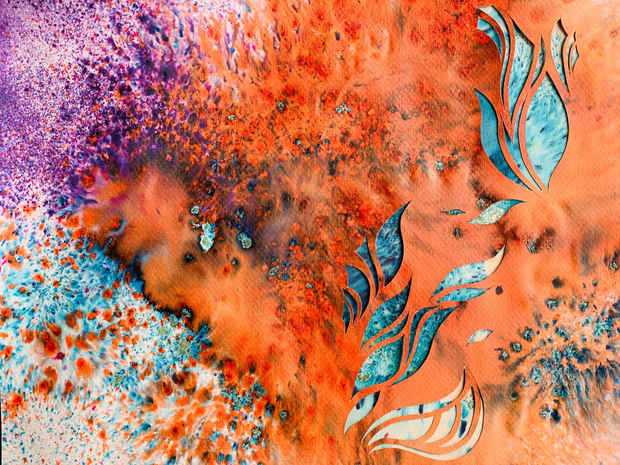Marisa Morán Jahn + Rafi Segal “Aberturas”
Sapar Contemporary

[Image: Marisa Morán Jahn "Chispas (Sparks)" (2022) Hand-dyed paper. 4 x 5 1/8 in.]
This event has ended.
Sapar Contemporary presents Aberturas, a solo exhibition by Artist + Architect Duo Marisa Morán Jahn and Rafi Segal. The duo’s first NYC exhibition highlights the aesthetic language characterizing their socially engaged, civic scale projects. The sculptures and two dimensional artworks in Aberturas (in English, openings, passages, portals) are inspired by the Meso-American and Chinese papercut art forms whose punctures are said to let the past through. Presented for the first time in a fine art gallery context, the works on view at Sapar Contemporary draw attention to their collaborative works’ intense bursts of color, play of forms and shadows, and geometric patterns of solids and voids.
The works in this exhibition are created through a dialogical process between the process of painting, etching, and perforating the two dimensional plane and folding, cutting, and transforming the surface into three dimensional spaces and voids. The cuts form clusters that function as both individual and as a group: calligraphy hovering on the edge of language, crystals, flocks, flames, or synapses.
For Jahn, who is of Chinese and Ecuadorian descent, adapting the transnational tradition of perforating paper is a reflective process. “Each cut is a portal or passage between worlds, and the artwork’s surface represents a threshold. In other words, the artwork makes visible — and is — the in-between. The incisions ask a question: To what degree and how shall the surface be open, hence how much past — and which pasts — do you want to let through?” Jahn’s work, which integrates social practice, performance, film, and two dimensional works, is characterized by its imaginative, colorful, and playful approach.
As in his architectural practice, Segal questions the design of buildings as ‘closed objects’ in favor of more porous conditions that invite interactions between public and private, mass and void, landscape and interiors, and more. The adaptation of patterns become ways to contextualize a project’s site and cultural context. As an Israeli architect, Segal’s interest in Ottoman and Islamic architecture and ornamentation critiques the overarching adaptation of Western forms in Israeli architecture and posits instead inspiration from regional histories and traditions.
Recognized by the late architectural critic Michael Sorkin for his “elegant, subtle, site-sensitive” approach, Segal’s work engages communities such as the affordable village-wide housing that the Rwanda Housing Authority uses to model houses in rural lands; and sustainability plans for New York City’s flood zones to mitigate climate change (impacting 1.2 million residents). Throughout his work, as in his award winning proposal for the National Library of Israel, surfaces create openings to convene people, form pathways to direct movement, and become roofs to unite disparate spaces.
Marisa Morán Jahn: An artist of Ecuadorian and Chinese descent, Marisa Morán Jahn’s works redistribute power, “exemplifying the possibilities of art as social practice” (ArtForum). Codesigned with new immigrants and working families, Jahn’s public artwork, civic media tools, installations, films, architectural and urban-scale collaborations have engaged millions both on the street and at venues such as the United Nations, Tribeca Film Festival, Obama’s White House, Museum of Modern Art, and Venice Biennale of Architecture. Her work has reviewed in The New York Times, the BBC, Univision, Hyperallergic, Art in America, Architectural Review, Wall Street Journal, Los Angeles Times, PBS, and hundreds more. She has received grants and awards from Sundance, Creative Capital, and is currently an Artist in Residence at The National Public Housing Museum, a Senior Researcher at MIT. Jahn has taught at Columbia University, MIT (her alma mater), and Parsons/The New School where she is the Director of Integrated Design. With Rafi Segal, Jahn co-authored a book, Design & Solidarity (Columbia University Press, 2023) and co-founded Carehaus, the U.S.’s first care-based co-housing project.
Rafi Segal is an architect and Associate Professor of Architecture and Urbanism at MIT. His work involves design and research on the architectural, urban and regional scale, currently focused on how emerging notions of collectivity can impact the design of buildings and cities. His current ongoing work includes designs for new communal neighborhoods in Israel, Boston, Rwanda, and the Philippines. Segal directs Future Urban Collectives, a new design-research lab at MIT that explores the relation between digital platforms and physical communities asking how architecture and urbanism can support and scale cohabitation, coproduction, and coexistence. Segal has exhibited his work at venues including Storefront for Art and Architecture; KunstWerk, Berlin; Witte de With, Rotterdam; Venice Biennale of Architecture; Museum of Modern Art; and the Hong Kong/Shenzhen Urbanism Biennale. He holds a PhD from Princeton University and a M.Sc and B.Arch from Technion, Israel Institute of Technology. With artist Marisa Morán Jahn, Segal is designing Carehaus, the U.S.’ first care-based co-housing building whose first site opens in Baltimore in 2023 and the co-author of Design & Solidarity.
Media
Schedule
from June 02, 2023 to July 15, 2023
Opening Reception on 2023-06-02 from 18:00 to 20:00